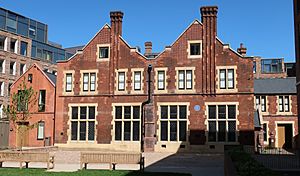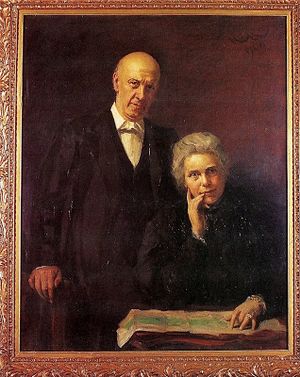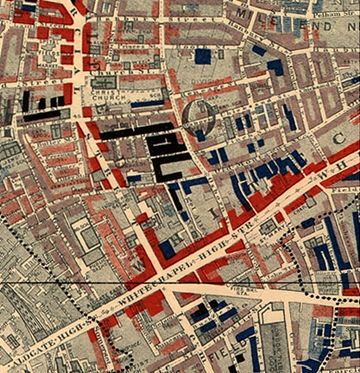Toynbee Hall facts for kids
Toynbee Hall is a charity that helps people dealing with poverty in the East End of London and other places. It started in 1884 and is located on Commercial Street in Spitalfields. It was the very first place of its kind connected to universities as part of the worldwide settlement movement. This movement aimed to bring people from rich and poor backgrounds closer together.
Henrietta and Samuel Barnett founded Toynbee Hall. They named it after their friend, Arnold Toynbee, an Oxford historian and reformer who had passed away the year before. Today, Toynbee Hall still works to connect people from all walks of life, hoping for a future where no one lives in poverty.
Contents
History of Toynbee Hall
Starting in Whitechapel
After they got married in 1873, Samuel and Henrietta Barnett moved to the Whitechapel area in the East End of London. Samuel was a vicar at St Jude's church. There, he saw how difficult life was for many people. In the late 1800s, Whitechapel was very crowded and had a lot of crime. Sadly, about 60% of children under five years old died in Whitechapel, mostly because of the poor living conditions.
Charles Booth, another social reformer, studied London's different social classes. He found that about 70% of people in the East End were in the lowest three groups. This showed how widespread poverty was.
Whitechapel was also a place where many immigrants came to live. After the Great Famine in Ireland in the 1800s, many Irish people settled there. Also, many Jewish immigrants came to Whitechapel to escape unfair treatment in Western Europe.
The Barnetts' Efforts
The Barnetts used their roles in the church to try and make Whitechapel better. They built a church library and held art shows. They also invited university teachers to give talks and took people from the area on trips to wealthy homes and universities. The Barnetts also encouraged officials to improve sanitation, housing, and to build more playgrounds and washhouses.
However, their efforts through the church didn't reach everyone in the East End. Many people were not involved with the church. To help more people, Samuel Barnett had an idea: he wanted university students to volunteer and share their knowledge and culture. He believed students could help the poor and also learn about poverty firsthand. This experience might help them find solutions.
Founding the First Settlement House
In 1883, Samuel Barnett gave a speech at St John's College, Oxford to get support for his idea. He got enough help, and a group called the "University Settlement of East London" was formed by Oxford University. With these ideas and university support, Barnett founded Toynbee Hall. It was the first "settlement house" in the world.
Named after the social reformer Arnold Toynbee, Toynbee Hall opened its doors on Christmas Eve in 1884. Samuel Barnett became the first leader, called the "warden." Students from Oxford and Cambridge universities came to work there.
By 1910, many more settlement houses were started in the United Kingdom and other countries like Holland, France, Germany, and the United States. In 1911, leaders of the movement created the National Federation of Settlements. One famous settlement house, Hull House in Chicago, was started by Jane Addams and Ellen Gates Starr in 1889 after they visited Toynbee Hall.
Early Programs and Services
Over the years, Toynbee Hall started many educational programs for the community. When it first opened, it offered lectures taught by university professors. In the 1890s, these classes covered over 134 topics, including literature, science, and ethics.
To encourage learning even more, 36 different clubs and societies were created for music, art, history, and science. One group, the "Toynbee Travellers," started in 1889 after some residents traveled to Belgium. Toynbee Hall also held "Smoking Room Debates" where community members and guests discussed important issues. This tradition lasted for over twenty years.
In 1899, the "Poor Man's Lawyer" service began. This program still offers free legal help to people who cannot afford it.
The Settlement Movement
The international settlement movement began at Toynbee Hall. It was a community center where university students chose to live, or "settle," among the less fortunate people in London's East End. Samuel Barnett said they came "to learn, as much as to teach, to receive as much as to give." Like most settlement houses, the students lived at Toynbee Hall. This helped them get to know their neighbors and understand their needs better.
Toynbee Hall was different because it did not try to convert people to Christianity, unlike some other groups like the Salvation Army. This is why it was named after Arnold Toynbee, a social reformer, and not a religious figure. Henrietta Barnett explained that the name would be "free from every possible savor of a mission."
From the very beginning, Toynbee Hall welcomed people of all faiths. Even though a Church of England cleric founded it, its main goal was education, not religious missions. Gertrude Himmelfarb, a historian, listed some of the activities offered:
- Evening classes on math, writing, drawing, and music.
- Afternoon classes for girls on dressmaking, cooking, and French.
- Evening discussions on legal ideas and current social issues.
By 1900, there were over 100 settlement houses in the United States and across the UK. In 1911, the leaders of the movement formed the National Federation of Settlements.
Toynbee Hall Today
Today, Toynbee Hall offers many programs and activities. These include services for young people, older people, and help with money matters. They also provide advice, free legal help, and ways for the community to get involved.
Each year, more than 400 volunteers help Toynbee Hall deliver its services.
In 2006, Toynbee Hall started Capitalise, a free debt advice service for all of London. It aimed to help 20,000 people a year with their money problems. In April 2019, this service was renamed Debt Free London.
In 2007, the Toynbee Studios opened. This part of the building has dance and media studios, and a theater.
Buildings of Toynbee Hall
Toynbee Hall, the main building, is on Commercial Street in Spitalfields, in the London Borough of Tower Hamlets. Elijah Hoole designed it in a Tudor-Gothic style. It officially opened in January 1885. It was built where an old industrial school used to be, next to St Jude's church (which was later taken down in 1927).
The building was recognized as a Grade II listed building in 1973, meaning it's historically important. On the front of the building, there is a Greater London Council blue plaque. This plaque was put up in 1984 to remember Jimmy Mallon, who was the warden from 1919 to 1954.
Since it was founded, the charity has grown. It now uses the original building plus several extensions and other buildings nearby.
People Connected to Toynbee Hall
Wardens
- 1884–1906 Samuel Barnett
- 1906–11 Thomas Edmund Harvey
- 1914-17 John St George Currie Heath
- 1919–54 James Joseph Mallon
- 1954–63 Arthur Eustace Morgan
- 1963–64 Jack Catchpool
- 1964–72 Walter Birmingham
- 1972–76 Anthony Locke
- 1977–87 Donald Piers Chesworth
- 1987–92 Alan Lee Williams OBE
- 1992–98 Alan Prescott
- 1998–2008 Revd Professor Luke Geoghegan
- 2008–17 Graham Fisher
- 2017–22 James Minton
- 2023– Rebecca Sycamore
Chair of Trustees
- 1884–96 Philip Lyttelton Gell, first chairman
- Charles Alfred Elliott
- 1911–25 Alfred Milner
- 1933–45 Cosmo Lang
- 1966 Lord Blakenham
- 1982–5 John Profumo
- 1985–90 Sir Harold Atcherley
- 1990–2002 Roger Harrison
- 2002–2009 Christopher Coombe
- 2009–2015 Ben Rowland
- 2015–2022 Julian Corner
- 2022– Steven Burns
Notable People Associated with Toynbee Hall
- Important social reformers like R. H. Tawney and Clement Attlee lived at Toynbee Hall.
- William Beveridge started his career there from 1903 to 1905.
- Famous visitors included Lenin and Guglielmo Marconi. Marconi even showed his first wireless invention at Toynbee Hall on December 12, 1896.
- John Profumo spent a lot of time helping the Hall from the 1960s onwards.
- American social reformers like Jane Addams visited Toynbee Hall. This visit inspired them to create Hull House in Chicago.
- Sir Nicolas Bratza volunteered at Toynbee Hall's Free Legal Advice Centre in the 1970s. He later became the President of the European Court of Human Rights. In 2014, he became an Ambassador for Toynbee Hall.
Associated Organizations
- Charles Robert Ashbee started his Guild of Handicraft while living at Toynbee Hall in the late 1880s.
- The Whitechapel Art Gallery (founded in 1901) grew from art shows organized by Henrietta Barnett.
- The Workers Educational Association (WEA) was founded here in 1903.
- Child Poverty Action Group was started at a meeting held at Toynbee Hall in 1965.
- Stepney Children's Fund
Images for kids
-
An Arts and Crafts style clock tower.
-
A Blue plaque honoring Jimmy Mallon.









